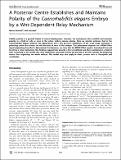A posterior centre establishes and maintains polarity of the Caenorhabditis elegans embryo by a Wnt-dependent relay mechanism
Abstract
Cellular polarity is a general feature of animal development. However, the mechanisms that establish and maintain polarity in a field of cells or even in the whole embryo remain elusive. Here we provide evidence that in the Caenorhabditis elegans embryo, the descendants of P1, the posterior blastomere of the 2-cell stage, constitute a polarising centre that orients the cell divisions of most of the embryo. This polarisation depends on a MOM-2/Wnt signal originating from the P1 descendants. Furthermore, we show that the MOM-2/Wnt signal is transduced from cell to cell by a relay mechanism. Our findings suggest how polarity is first established and then maintained in a field of cells. According to this model, the relay mechanism constantly orients the polarity of all cells towards the polarising centre, thus organising the whole embryo. This model may also apply to other systems such as Drosophila and vertebrates.
Citation
Bischoff , M & Schnabel , R 2006 , ' A posterior centre establishes and maintains polarity of the Caenorhabditis elegans embryo by a Wnt-dependent relay mechanism ' , PLoS Biology , vol. 4 , no. 12 , pp. e396 . https://doi.org/10.1371/journal.pbio.0040396
Publication
PLoS Biology
Status
Peer reviewed
ISSN
1544-9173Type
Journal article
Collections
Items in the St Andrews Research Repository are protected by copyright, with all rights reserved, unless otherwise indicated.

